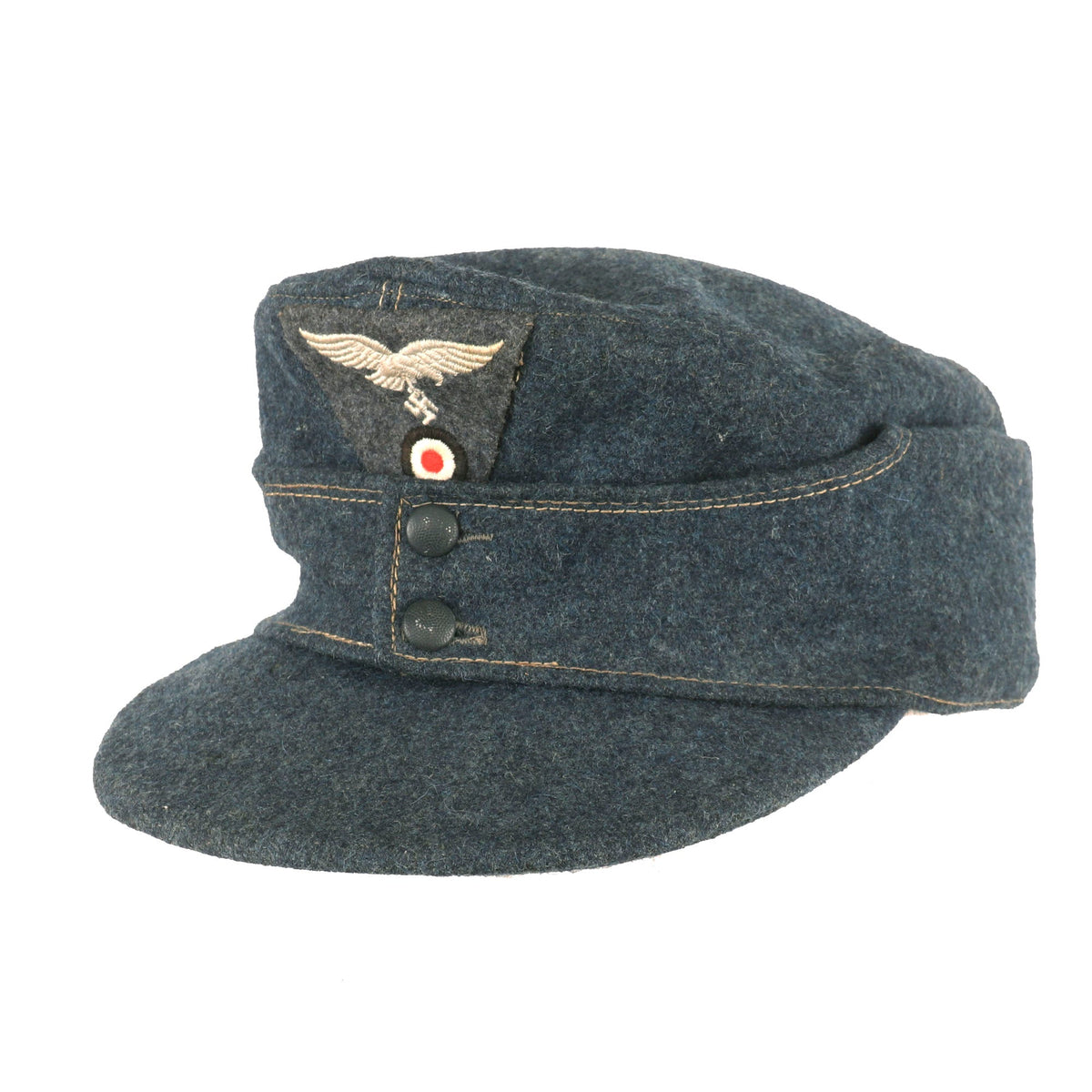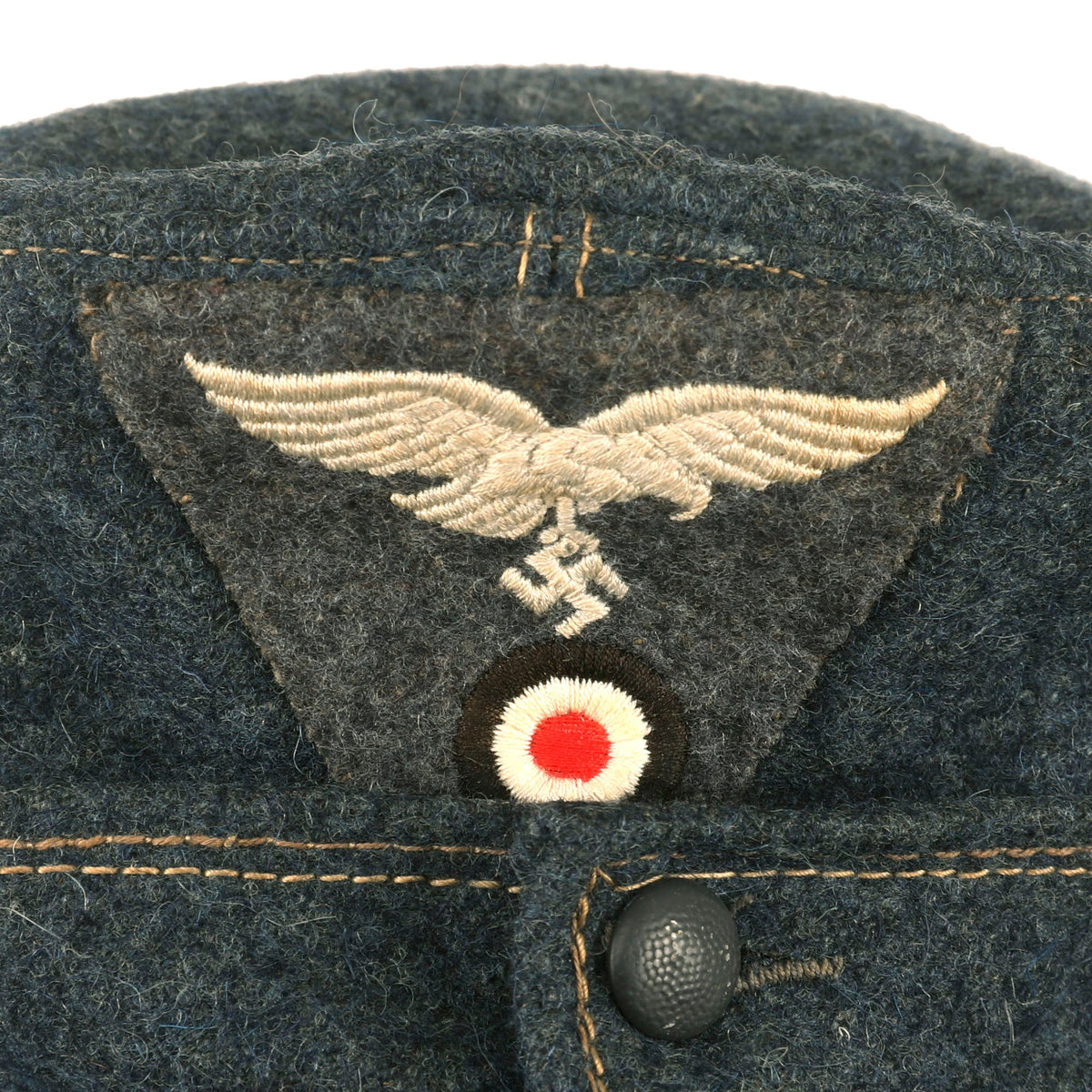Original German WWII 1944 Dated Luftwaffe M43 Einheitsmütze Field Cap with RBNr. – Size 57 Original Items
$ 795,00 $ 238,50
Original Item: Only One Available. This is a very nice example of a Luftwaffe M43 Einheitsmütze Wool field cap, with a great service worn look. The cap is constructed of Luftwaffe blue Fliegerblau (Flyer’s Blue) blue/grey wool, and has the correct “fold down” skirt for colder weather. It features two pebbled aluminum buckles to the front, securing the skirt, and has the correct loops on the underside.
The peak of the cap has a very nice cap eagle with cockade underneath, both machine embroidered and hand sewn on. The interior of the cap is a gray rayon material, which is standard for this type of cap. It has light sweat stains around the edge, and the crown still has the original issue markings:
1944(?)
0/0501/0015
57
German RBN Numbers, or Reichsbetriebsnummer, also known as the National Business Number, were an alternative to the 3 letter codes in use late in the war. The first number 0 is the prefix for “industry”, while 0501 is the location code, and manufacturer 0015 in is a specific maker. The records of these are very incomplete, so we have not been able to locate this specific manufacturer. We have however had several examples from this maker before.
The visor is still in good condition, though the cardboard stiffener definitely has some ripples, but no breaks. The exterior is in very good condition, with little sign of moth, if any. There are not any tears or repairs that we can see.
Overall condition is really good, showing light wear and no major damage from mothing or use. There is just a bit of yellowing to the exterior fabric, which shows very little in the way of wear, so this is really how they looked when first issued. A lovely example, ready to add to your collection!
The M43 Einheitsmütze (Unit Cap) is a variety of “Ski Cap” and was based on the Bergmütze (Mountain Hat) used by Austrian and German Gebirgsjäger (Mountain Troops) during WWI. Germany had adopted it in 1915, and after the war it spread throughout the military.
The skirt that surrounds the cap is made in the same wool as the cap, and can be folded down over the ears, though this was rarely done outside of the Mountain troops, which had a double-thickness skirt. The skirt has a small dip in the front quarter with a divide secured by one aluminum button which is covered by an embroidered cockade. The small section in the front quarter was built shorter to show the insignia, and cover the wearer’s chin or mouth, without disturbing breathing by covering the nose. There were also later M43 caps, such as those used by the DAK, that omitted the skirt entirely, as it had little use in the desert heat.
Reichsbetriebsnummer or RB number (also represented as RB Nr or Rbnr). Before the war, the Germans set up a system for registering and recording the factory information, the Reichsbetriebskartei. This was to help enable machine tabulation of facts and figures. It was from this that the Reichsbetriebsnummer came into being. The Reichsministerium für Rüstung und Kriegsproduktion (Ministry for Armaments and War Production) files survive today in the Bundesarchiv, however, these are only fragmentary. There is a holding file from the working group created by the Office of Machine Reporting in the Armament Office of the Reich Ministry for Armaments and War Production – their main focus was the operations of the industry group for which an economic interest was Armour production. This index provides information on the most important data of the companies covered by it, production profile, operating area, number of employees and the responsible operator.
As a prerequisite for the intended use of the punch-card method in the armaments industry, it was this system which gave rise to the Rbnr. The operating numbers were assigned by the competent local district offices of Machine reporting. (Bezirksstellen des Maschinellen Berichtswesens.) The index is in the form of index cards that are accessible numerically (approximately 14 meters of index cards!). Access to this register is only possible through the naming of this company, stating the place of production. The Reichsministerium für Rüstung und Kriegsproduktion files have multiple entries on the introduction of the factory and also the lot no.
The Rbnr code was used from 1943 onwards and replaced the makers name and address (or company logo) on government contract uniforms, caps and field equipment and knives. It is either rubber ink stamped on cloth or die stamped onto leather & metal items. It has been written countless times that this numeric code system was introduced as a security measure to help mask production locations. This was not the case but it was perhaps, a helpful by- product of the system. It is not unknown to find the Rbnr together with the maker’s info. Had it been a security measure, clearly this practise would have been banned.
So what was the Rbnr? It was a nine digit number and was normally represented thus: RB Nr: 0/000/0000.
The first prefix number could range from 0 through to 9. This number determined the membership of the various groups in the realm of Trade and Industry (Reichsgruppenleitzahl)
• 0 Industry
• 1 Crafts
• 2 Commercial wholesale trading companies
• 3 Banking
• 4 Insurance Companies
• 5 Energy (Electrical companies and such)
• 6 Tourism (Including Hotels, Wine and Mineral Water companies)
• 7 Traffic
• 8 Food Industry
• 9 Not otherwise mentioned groups
Fast Shipping with Professional Packaging
Thanks to our longstanding association with UPS FedEx DHL, and other major international carriers, we are able to provide a range of shipping options. Our warehouse staff is expertly trained and will wrap your products according to our exact and precise specifications. Prior to shipping, your goods will be thoroughly examined and securely secured. We ship to thousands clients each day across multiple countries. This shows how we're dedicated to be the largest retailer on the internet. Warehouses and distribution centres can be located throughout Europe as well as the USA.
Note: Orders with more than one item will be assigned a processing date depending on the item.
Before shipping before shipping, we'll conduct a thorough inspection of the items you have ordered. Today, the majority of orders will be delivered within 48 hours. The delivery time will be between 3-7 days.
Returns
The stock is dynamic and we cannot completely manage it because multiple stakeholders are involved, including our factory and warehouse. So the actual stock may alter at any time. It's possible that you may not receive your order once the order has been made.
Our policy is valid for a period of 30 days. If you don't receive the product within 30 days, we are not able to issue a refund or an exchange.
You can only return an item if it is unused and in the same state as the day you received it. You must have the item in its original packaging.
Related products
Uncategorized
Uncategorized
Uncategorized
Uncategorized
Uncategorized
Uncategorized
Angolan Rebel 1970s era 60mm Inert Display Mortar from Angolan Civil War Original Items
Uncategorized
Uncategorized
Uncategorized
Uncategorized
Uncategorized
Uncategorized
Australian WWII Owen MK1 Machine Carbine SMG Custom Fabricated Replica with Sling Original Items
Uncategorized
Uncategorized
Armoured Fighting Vehicles of the World: AFVs of World War One (Hardcover Book) New Made Items
Uncategorized
Uncategorized
Band of Brothers ORIGINAL GERMAN WWII Le. F.H. 18 10.5cm ARTILLERY PIECE Original Items












































































